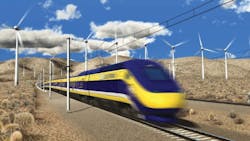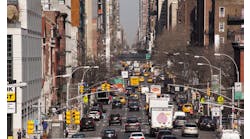By: Peter Gertler with Robert Doty, Randy Wade and John Parola
Even with all the controversy, we can argue that America’s passenger and high-speed rail program is experiencing its best of times so far.
Congress has appropriated more than $10 billion for the effort in the past three years. Thirty-two states and the District of Columbia are advancing numerous projects. And, about 62% of Americans say they would use high-speed rail service between U.S. metro areas, according to the American Public Transportation Association.
Despite the unprecedented activity and revitalizing benefits of high-speed rail, such as job creation, greater mobility, convenience and energy savings, the mode has been marginalized as a partisan issue. In July, Congress passed MAP-21, a two-year transportation authorization bill, without mentioning high-speed rail. For states with projects under way, it is a disconnect of significant proportions.
Thanks to state efforts, the passenger and high-speed rail conversation is ongoing and maturing. Realizing we cannot simply build more freeways and airports to reduce congestion and improve mobility, Americans are beginning to acknowledge high-speed rail as a critical element of a balanced, efficient multimodal transportation system.
Several factors will continue to drive funding and intercity passenger rail:
* There is tremendous support and demand for it;
* High-speed rail supports economic development;
* Our highways and airports continue to be congested, and states are struggling with how to add highway lane capacity and new runways in constrained urban areas; and
* As the world economy moves forward and countries recover, gas prices will spike because of demand and we will need more fuel-efficient transportation.
Plus, there is a backlog of work to be done. Projects have been implemented from Maine to Merced, Calif. The following are highlights.
California leading the pack
In July 2012, the state legislature confirmed the concept of high-speed rail by approving $2.7 billion in bonds (a local match to $3.3 billion in American Recovery and Reinvestment Act funds) to design and construct a 130-mile section of high-speed rail between Merced and Fresno known as the Central Valley Corridor and regarded as the backbone of California’s planned 800-mile system. The line will be new track designed to high-speed-rail standards with two stations and a maintenance facility.
By the end of this year, the California High-Speed Rail Authority will have selected a design-build contractor for the project. Construction is set to begin the first quarter of 2013.
The biggest hurdle now will be sustaining a new business case for high-speed rail’s continued development in California. Originally based on full system build-out, the authority’s high-speed rail program has evolved to one of incremental development.
Why the shift in strategy? The authority has learned that people will approve spending when they know the money will stay in their communities and they will benefit directly from it. As a result, the authority plans to win over the population one community at a time. When all is said and done, there will be a full system in place.
Northeast corridor: A powerhouse of projects
In July 2012, Amtrak released its updated vision for the Northeast Corridor (NEC), a 457-mile track that stretches from Boston to Washington, D.C. In the report, Amtrak outlined plans for developing a 438-mile dedicated, next-generation high-speed-rail system, where trains would run between New York City and Boston or Washington in 94 minutes.
Amtrak’s stair-stepped, phased approach would build various segments of the system over time with completion in 2040. The program, estimated at $151 billon, would create 40,000 construction jobs a year for 25 years and 22,000 permanent jobs. Funding is in place for 2012-14. Anything beyond that is uncertain.
A centerpiece of Amtrak’s vision, the Gateway Project is an ambitious effort to create new alignments into New York City, including two tunnels under the Hudson River, two portal bridges and a new signature station in New York. The project would address a range of capacity, safety and operational needs in a congested segment from Newark, N.J., to Manhattan. Amtrak is planning preliminary engineering and environmental work in 2013. The project has a 2025 proposed completion date.
Other developments along the NEC:
* Amtrak’s Morrisville-New Brunswick, N.J., corridor is in design. This project will add signal and track upgrades, improve power substations and overhead wire systems to increase capacity and boost speeds to 165-185 mph;
* Contracts for program management and design services are nearing award to replace Amtrak’s 140-year-old, speed-restricted and structurally deficient Baltimore and Potomac Tunnel. A new tunnel would nearly triple speeds from about 35 to 90 mph;
* A designer has been selected for the Kingston project in Rhode Island. The state was granted $25 million for design and construction of an additional 1.5 miles of third track in Kingston, so high-speed trains operating at 150 mph can pass slower trains on a heavily traveled section of the NEC;
* Design of double-track segments is under way along the Connecticut Department of Transportation’s New Haven, Conn., to Springfield, Mass., corridor. Trains will travel up to 110 mph;
* New York state’s programmatic environmental impact statement for high-speed rail from New York City to Niagara Falls is nearing completion. Speeds on the 463-mile Empire Corridor have not been determined but could be anywhere from 110 to 125 mph;
* Amtrak has plans to upgrade and expand its shops and yards to accommodate the longer next-generation high-speed rail trains;
* Pennsylvania is rebuilding an interlocking near Harrisburg that will improve trip times and reliability on the Keystone Corridor. The project is in design; and
* A $32.5 million federal grant received in September 2011 is allowing the Massachusetts Department of Transportation to complete all necessary environmental reviews, as well as preliminary engineering to expand Boston’s historic South Station.
The concentration of investment in California and the Northeast are logical, rational developments. These are the areas were population densities are the highest and urban growth is the strongest. They are where change is needed most. They also are where we likely will see the first signs of construction, but they are not the only hotbeds of high-speed rail activity.
The Midwest: High-speed rail’s untold story
Largely overlooked is the Midwest Regional Rail Initiative. This program, a 3,000-mile system encompassing nine states, is moving toward implementation with more than $3.5 billion in Federal Railroad Administration (FRA) grants. Projects are in construction; equipment is being procured; multiple planning studies are under way.
Fanning out from Chicago in a hub-and-spoke pattern, these corridors will accommodate speeds of up to 110 mph. The most advanced and high-profile projects in this region are the Kalamazoo-Dearborn portion of the Chicago-to-Detroit/Pontiac corridor and the Chicago-St. Louis corridor. Both corridors are in the implementation phase and have sufficient funding to go into service.
Illinois received two major grants—$1.2 billion in January 2010 and another $186.3 million in May 2011—to begin implementation of the Chicago-St. Louis corridor at speeds up to 110 mph. At press time, an inaugural run on a 14-mile test segment of the Chicago-St. Louis corridor was scheduled for September 2012. Once construction is complete, Illinois plans to begin operating trains on the entire 284-mile corridor over the next four to five years.
Michigan received $346 million to purchase, design, enter into construction and operate the Kalamazoo-Dearborn portion of the Chicago-to-Detroit/Pontiac corridor. Construction on the 135-mile corridor is scheduled to begin this year and will be completed over the next three construction seasons. Amtrak already is operating trains at speeds of up to 110 mph on 80 miles of a 97-mile stretch between Kalamazoo, Mich., and Porter, Ind. The inaugural run occurred this past February.
Other notable developments:
* Planning and environmental work is under way from the Twin Cities to Milwaukee and from Chicago to Omaha. Once planning is complete, each of these corridors will be funding-ready;
* Illinois received $230 million to establish new service in the Chicago-Rock Island/Moline corridor. The state is proceeding with design and construction;
* Indiana received a $71 million FRA grant in January 2010 for the Indiana Gateway Project, which will improve reliability of Amtrak service between Chicago, Detroit and Cleveland;
* Iowa is conducting a $2 million Tier 1 National Environmental Policy Act (NEPA) study for service from Omaha, Neb., to Rock Island/Moline, Ill., as part of the Chicago-Omaha corridor;
* Michigan received a $3.2 million award to conduct a Tier 1 NEPA service development plan for the Chicago-Detroit/Pontiac corridor; and
* Minnesota received $600,000 for a Tier 1 NEPA study of the Twin Cities-Milwaukee corridor. The state expects to complete Tier 1 work this year. With funding provided by the state, Olmsted County issued a request for proposals this past summer for $2.3 million in work for a Tier 1 NEPA study for its Rochester-Twin Cities corridor.
Texas in high gear
The speed at which Texas has advanced its high-speed rail program is impressive. Since 2009, the state has:
* Added a rail division to the Texas Department of Transportation (TxDOT);
* Adopted the Texas Rail Plan with significant public input;
* Received nearly $6 million in federal grants (which became available when Florida, Ohio and Wisconsin returned their federal monies) to study the feasibility, level of service and frequency of service of a corridor from Oklahoma City to Dallas, Dallas to San Antonio and potentially to south Texas. The study is scheduled to be completed by mid-2014;
* Accepted a $15 million federal grant from the High-Speed Intercity Passenger Rail Program to fund preliminary engineering and service-level NEPA development for the Dallas/Fort Worth-Houston corridor. Those activities also are under way. The 239-mile trip, nearly four hours by car, could be shortened to about 90 minutes;
* Begun studying the viability of a new Amtrak line that would follow I-20 from Dallas/Fort Worth south to Shreveport/Bossier City, La., to improve connectivity between their respective airports;
* Recently completed an engineering and environmental feasibility study of a high-speed intercity passenger rail corridor between Austin and Houston; and
* Begun developing a Statewide Ridership Model to help determine realistic ridership numbers along corridors throughout the state, such as Dallas/Fort Worth-Houston. The entire statewide model will not be completed until the first quarter of 2013, but corridor testing could start as early as August 2012.
If funding is available through the federal government, corridors such as Dallas/Fort Worth-Houston, Dallas/Fort Worth-San Antonio and Austin-Houston could see high-speed rail operating in as little as 10 to 15 years.
In 2010, the Central Japanese Railway Co. began promoting a Houston-Dallas high-speed rail corridor. The group is conducting an independent engineering and feasibility study. It believes the entire corridor can be built without any government funding and actively is seeking private investors to fund the $10 billion effort.
Meanwhile, TxDOT is continuing to conduct its own preliminary engineering and NEPA studies. Although currently unrelated, these efforts may become complementary in that once TxDOT has gained environmental clearance, the Central Japanese Railway could step in and begin implementation.
Georgia emerging
Georgia is building on Atlanta’s traditional role as the rail hub of the South. After completing a $1.5 million feasibility study of three corridors (Atlanta-Birmingham, Atlanta-Chattanooga-Nashville-Louisville and Atlanta-Savannah-Jacksonville) the state DOT now is conducting a Tier 1 NEPA study of the Atlanta-to-Charlotte, N.C., corridor, which would provide important connectivity between Atlanta and the Northeast Corridor.
The unique $4.8 million study will evaluate 110-mph operations on the shared-used corridor, as well as fully electrified operations at speeds between 180 and 220 mph on a grade-separated greenfield or potential interstate highway corridor. North Carolina and South Carolina also are active participants. The study is expected in August 2013.
Now is the time to get on track
States are moving forward with passenger and high-speed rail investments, but each can take its program only so far without the reassurance of a secure, sustainable source of funding. To see high-speed rail come to fruition in the U.S. as a vital component in a multimodal transportation system, we must insist Congress create a secure, sustainable funding source. We must take a page from these states, which are making real progress, and remain bullish on high-speed rail in America.
About The Author: Gertler is chair of rail and transit services for HNTB Corp. He can be contacted at 510.208.4599 or [email protected]. Doty is high-speed rail programs director for HNTB. Wade is director of Midwest regional rail for HNTB. Parola is the high-speed rail ca



